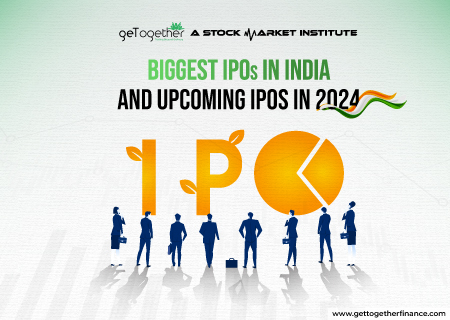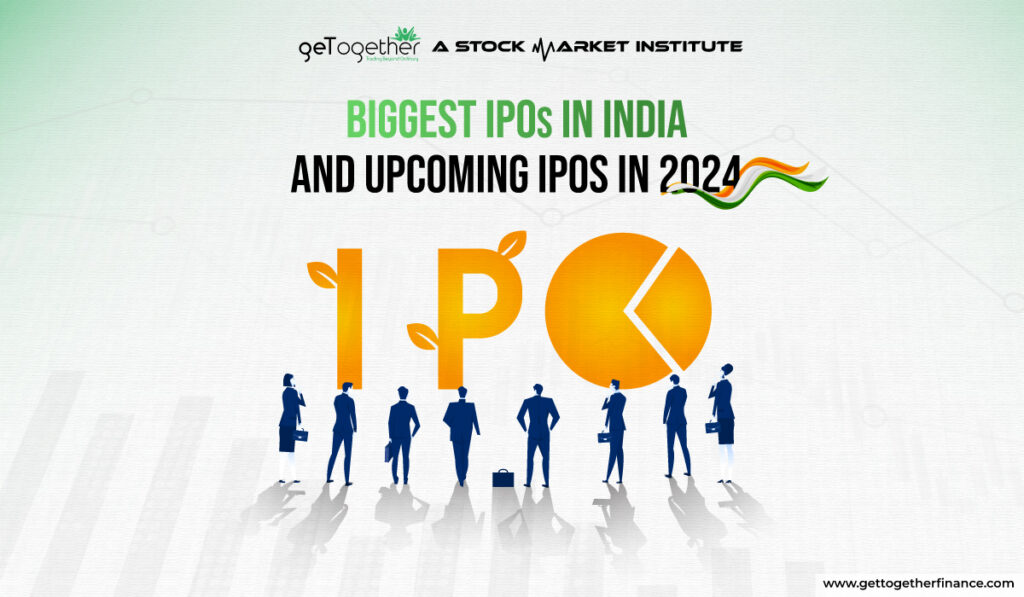Biggest IPOs in India and Upcoming IPOs in 2024


Table of Contents
ToggleIntroduction
The Indian stock market has witnessed a surge in Initial Public Offerings (IPOs) in recent years, with some deals breaking all records. In Q4 2023 alone, the stock market witnessed a staggering 72% surge in IPOs compared to the previous year. These mega-IPOs have not only raised significant capital for companies but have also captured the attention of investors worldwide. But what are IPOs in India and what is its process of listing? With this blog, we will dive into the world of IPOs, analysing their impact on the market. Further, this will explore the biggest IPOs in India, including the list of upcoming IPOs in 2024.
Indian IPOs Market History

The history of IPOs in India doesn’t go way back, in fact, it began in the early 1990s. With the emerging economies and stock market regulations, the Indian IPO market has grown significantly over the years. Here is a brief history of the Indian IPO market, worth noting;
Early Years (1990s to Early 2000s)
With the liberalisation of the Indian economy in 1991, The IPO market opened up and experienced a gradual increase. Many companies went public during this period and ICICI was one of the early prominent IPOs. The late 1990s witnessed a surge in IPOs, mirroring the global dot-com boom. However, the dot-com bubble burst in the early 2000s, leading to a market crash and a sharp decline in IPO activities.
Revival and Consolidation (Mid-2000s to Late 2000s)
With the willpower of market recovery, the Indian IPO market gradually revived, with booming sectors like banking, oil and gas, and infrastructure. Reliance Industries’ IPO left a landmark event in this era.
Global Financial Crisis Impact (2007 – 2009)
Also known as the Great Recession worldwide, the 2008 global financial crisis (GFC) brought IPO activity to a near standstill, leading to a market freeze and a cold wave among investors, leading to a slowdown in IPO activities too.
Resurgence and Growth (2010 onwards)
With the revival of the market, the Indian economy showed signs of strength, leading to a resurgence in IPO activity. During this phase, Coal India, the largest coal producer, made one of the most successful IPOs in India.
Despite the COVID-19 pandemic, the Indian IPO market kept growing, witnessing many high-profile IPOs for companies like Nykaa, Zomato, etc. In just 2021, the Indian IPO market raised over ₹1 lakh crore through IPOs in 2021. Today, the Indian IPO market is more mature under robust regulation of SEBI (Securities and Exchange Board of India), holding a wider investor participation.
Biggest IPOs in India Till 2024
From the beginning till the modern mid-2020s era, the Indian IPO market has come too far. In 2023 standalone, 53 Indian corporates released their IPOs to raise funds as per the Prime Database.
Here we have listed some of the biggest IPOs till now in the Indian history to give you a glimpse in the past:
| Issue Name | Issue Size (₹ Cr) | Listing Date | Offer Price (₹) | Listing Price (₹) | Listing Gain (%) |
| Life Insurance Corporation of India (LIC) | 21,008.48 | May 17, 2022 | 949 | 875.45 | -7.75 |
| One 97 Communications Ltd (Paytm) | 18,300 | Nov 18, 2021 | 2,150 | 1,564.15 | -27.25 |
| Coal India Ltd | 15,199.44 | Nov 04, 2010 | 245 | 342.35 | 39.73 |
| Reliance Power Ltd | 11,563.20 | Feb 11, 2008 | 450 | 372.5 | -17.22 |
| General Insurance Corporation of India | 11,175.84 | Oct 25, 2017 | 912 | 870.4 | -4.56 |
| SBI Cards and Payment Services Ltd | 10,354.77 | Mar 16, 2020 | 755 | 683.2 | -9.51 |
| NMDC Ltd | 9,930.45 | Mar 30, 2010 | 300 | 294.65 | -1.78 |
| The New India Assurance Company Ltd | 9,600 | Nov 13, 2017 | 800 | 725.05 | -9.37 |
| DLF Ltd | 9,188.00 | Jul 05, 2007 | 525 | 583.75 | 11.17 |
| HDFC Standard Life Insurance Company Ltd | 8,695.00 | Nov 17, 2017 | 290 | 344.25 | 18.1 |
Upcoming Biggest IPOs in India

Here is a list of the upcoming biggest IPOs in India that can signal a leading opportunity for investors:
| Company | Sector | Estimated IPO Details |
| Reliance Jio | Telecommunications | ₹80,000 – ₹1,00,000 crores |
| Tata Sons | Conglomerate (Holding Company) | Up to ₹55,000 crores |
| Hyundai Motor India Ltd | Automotive | ₹25,000 crores |
| Tata Passenger Electric Mobility | Automotive (Electric Vehicles) | ₹16,000 crores |
| Tata Digital | E-commerce/Digital Services | ₹12,000 crores |
| Bajaj Housing Finance | Financial Services | ₹7,000 crores |
| PharmEasy | E-commerce/Healthcare | ₹6,250 crores |
| Ola Electric | Automotive (Electric Vehicles) | ₹6,200 crores |
Why Should Invest in These Companies

Here is a quick view into the company profile and suitable investors who can invest in biggest IPOs:
Reliance Jio: The company is part of Reliance Industries and is one of the largest telecom companies in India. Since its launch in 2016, it has transformed the telecom market and is now expanding into digital services like e-commerce and entertainment. The expected listing date is not finalised yet but is tentatively in 2024. Investors who want to grow their investment in the digital and telecom service sector can invest in this IPO.
Tata Sons: This is the main holding company of the Tata Group, including many well-known companies in various sectors like steel, automotive, and IT. The expected listing date of the IPO is September 2025. Investors looking for a stable investment in a well-respected company with diverse interests should consider this IPO.
Tata Passenger Electric Mobility: TPEM is a part of Tata Motors that focuses on electric vehicles (EVs) and is one of the integral parts of India’s sustainable transportation mission. Investors interested in the future of the transportation sector, EV market, and sustainable technologies can invest in this company.
Hyundai Motor India Ltd: It is a subsidiary of the South Korean car manufacturer Hyundai and is one of the largest car makers in India, known for its range of vehicles, including electric cars. If you want to diversify your portfolio in the automotive sector, this is one of the biggest IPOs after TPEM.
Also Read: Impact on IPO Market
Who Can Invest in Biggest IPOs?

Generally, any adult individual with a PAN card and a Demat account can invest in an IPO. However, the Securities and Exchange Board of India (SEBI) classified major four types of investors to claim shares during an IPO process:
Qualified Institutional Investors (QIIs):
This category includes large financial institutions such as mutual funds, insurance companies, banks, and pension funds. These investors are considered to have the expertise and the financial capacity to invest large sums of money in the market. For example, SBI Mutual Fund, ICICI Prudential Life Insurance, and HDFC Pension Fund.
Anchor Investors:
A subcategory of QIIs, anchor investors are institutional investors who are invited to invest in an IPO before it opens to the general public. They help build confidence in the issue by committing substantial investment and can only sell their shares after a lock-in period. For instance, Goldman Sachs, Morgan Stanley, or BlackRock.
Retail Investors:
Individual investors who invest up to ₹2 lakhs in an IPO fall under this category. SEBI mandates a specific portion of the IPO shares to be reserved for retail investors to encourage participation from small investors.
High-Net-Worth Individuals (HNIs) or Non-Institutional Investors (NIIs):
These are individual investors who invest more than ₹2 lakhs in an IPO. They do not fall under the retail investor category due to the larger size of their investments and are allotted shares under a separate quota.
Despite the above typical categories here are who can invest for bidding in an IPO:
Employees and Partners:
- Sometimes, a portion of the IPO shares is reserved for the employees, business partners, and other stakeholders to offer an opportunity to invest in the IPO.
Non-Institutional Investors:
- Corporate Entities: Companies and other large entities that want to invest major amounts of money can also participate in Biggest IPOs.
- Trusts and Societies: Various types of trusts and societies can invest in Biggest IPOs if they meet the necessary criteria set by the regulatory authorities.
Foreign Investors:
- Foreign Institutional Investors (FIIs): These are entities based outside the country where the IPO is happening but are allowed to invest in the IPO. They bring in foreign capital and are often keen participants.
These categories ensure a broad and diverse investor base, helping companies raise capital more efficiently and distributing ownership among different types of investors.
In A Nutshell
IPOs in India offer a unique opportunity for businesses and companies to raise funds from the public and expand their business. Investors can participate in IPOs to own a stake in promising companies early on, potentially benefiting from future growth and profits. However, investing in IPOs requires careful research and understanding of the company’s prospects and market conditions. It’s an exciting opportunity for both companies and investors alike, which requires due diligence and thorough fundamental knowledge to ace the game.
FAQs
How does an IPO work?
The company, with the help of investment banks, determines the issue price, and investors bid for shares. Shares are allocated based on demand.
What is the book-building process in an IPO?
It’s a method to determine the issue price based on demand from investors.
What is the difference between a primary and secondary market?
IPO happens in the primary market, while subsequent trading occurs in the secondary market, typically known as the stock market.
Can I apply for multiple IPOs simultaneously?
Yes, you can apply for multiple IPOs through the ASBA (Application Supported by Blocked Amount) process.
What happens if my IPO application is rejected?
If your IPO gets rejected, your application money is refunded to your bank account.
What is an anchor investor?
Large institutional investors who commit to buying a significant portion of the IPO.
What are the risks associated with investing in IPOs in India?
A few risks associated with investing in IPOs in India include market volatility, company performance risks, and the possibility of underperformance.



 Facebook
Facebook Instagram
Instagram Youtube
Youtube
